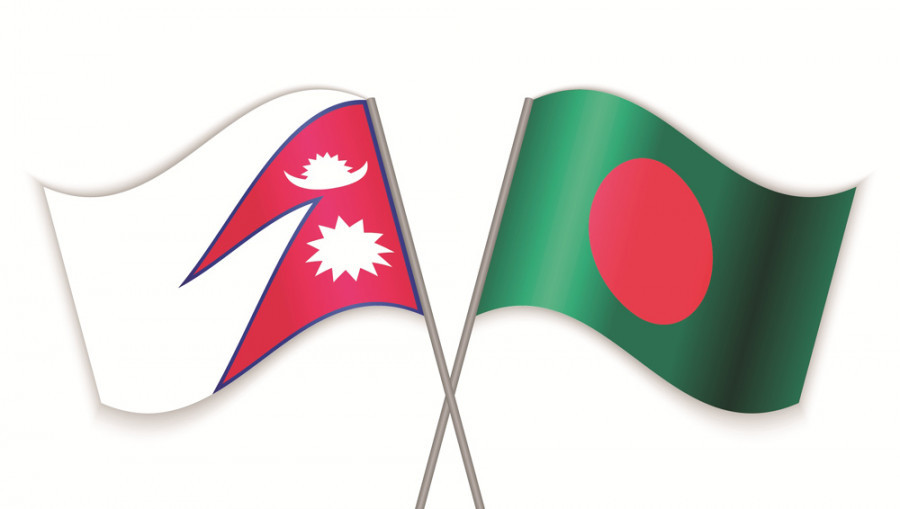National
Nepal, Bangladesh move towards tariff negotiation for trading of 40MW power
Bangladesh has sent a draft Request for Proposal to Nepal Electricity Authority asking the NEA to propose tariff.
Prithivi Man Shrestha
Nepal and Bangladesh are one step closer to a deal for the export of 40MW of electricity from Nepal as the two neighbours negotiate the tariff.
Once the two sides agree on a tariff to be charged, Nepal, Bangladesh and India are expected to sign a tripartite agreement under which Nepal exports power to Bangladesh for the first time.
When Prime Minister Pushpa Kamal Dahal visited India in May-June last year, the southern neighbour had promised to facilitate the export of 40MW electricity to Bangladesh. With Indian territory lying between Nepal and Bangladesh, it is necessary for both sides to take India on board in the energy trade.
“Bangladesh has sent us a draft request for proposal (RfP) in which we propose the tariff that we want to levy,” said NEA Managing Director Kul Man Ghising.
NEA officials said that even though the two sides have agreed on almost all issues concerning the export of 40MW of electricity, tariff is the only thing on which negotiation is yet to begin.
They said that once Nepal proposes a tariff, bilateral negotiation would begin on the issues.
“It may take 10 to 15 days for us to decide on the tariff to be proposed,” said Ghising. There will also be other terms of conditions agreed between the two sides in the RfP, according to NEA officials. They said the draft RfP was received early this week.
“Bilateral agreement on power trade has so far been in the form of a memorandum of understanding,” said Pradeep Kumar Thike, the deputy managing director who oversees power trade at the NEA. “With the RfP, understanding will be formalised in concrete terms and conditions.”
Nepal and Bangladesh earlier agreed to make an effort for the export of 40MW of power in the last wet (summer) season that began in May last year. But the plan has yet to materialise as the two sides failed to conclude negotiations. Nepal now expects to export power in the next wet season as the country itself may have to import power from India during the dry (winter) season as it usually does.
The state-owned utility said it would be flexible on tariffs in its maiden effort to export electricity to the country.
As a friendly gesture, Nepal plans to offer a reasonable tariff for the government-to-government deal, Ghising told the Post earlier. “A reference can be the existing electricity price in Bangladesh,” he said.
According to NEA officials, the transmission charges and service fees to be paid to the Indian authorities have been almost finalised. The transmission charges will be equivalent to what India’s power traders currently charge buyers and levied as per India’s open access rules.
Bangladeshi entities may also have to pay service charges to the NTPC Vidyut Vyapar Nigam Limited (NVVN), which is India’s nodal agency for cross-border power trade, for the agency’s efforts in obtaining its government’s regulatory approval.
When vital parameters, including the tariff, are determined, a tripartite agreement between the NEA, the Bangladesh Power Development Board and the NVVN will be signed as agreed during the meeting of the energy secretary-level joint steering committee between Nepal and Bangladesh in mid-May last year.
Nepal has not exported power to other countries except India. Both Nepal and India agreed, in principle, to involve Bangladesh as a partner for energy cooperation when they issued the Joint Vision Statement on Power Sector Cooperation in April 2022.
Though negotiations for the export of 40MW of power from Nepal to Bangladesh are ongoing, Bangladesh wants more power from Nepal.
Speaking at an interaction organised by the Centre for Social Inclusion and Federalism, an agency working in the field of diplomacy, in Lalitpur on Tuesday, Bangladeshi Ambassador to Nepal Salahuddin Noman Chowdhury said that his country’s existing generation has not been enough to meet the growing demand for power and Nepal could fill that gap.
“Currently, Bangladesh produces around 25,000MW of electricity against the demand of over 30,000MW,” said Chowdhury. “If Nepal gives us 3,000–4,000MW of power right now, we can consume all the supply.”




 17.29°C Kathmandu
17.29°C Kathmandu















